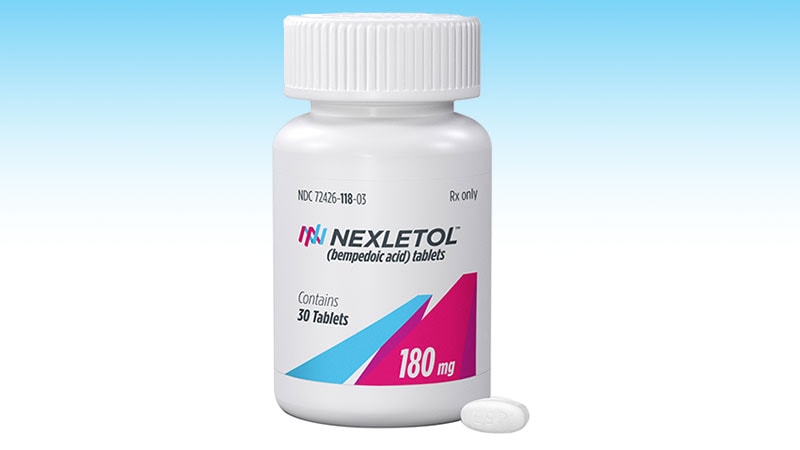Fitness
Bempedoic Acid Effective in Patients With Obesity

LYON, France — Bempedoic acid ( Nexletol) is safe for people with obesity and is effective at lowering lipid levels and rates of major cardiovascular events, according to a prespecified analysis of data from the CLEAR Outcomes trial.
The research, presented here at that European Atherosclerosis Society 2024, showed that among almost 6200 individuals with obesity, the ATP-citrate lyase inhibitor was associated with a 23% greater reduction in a four-component major adverse cardiovascular event composite endpoint than placebo.
“We think that reinforces the importance of intensive lipid-lowering, no matter how you do it, in high-risk patients,” said study presenter Stephen Nicholls, MD, PhD, director of the Victorian Heart Institute and professor of cardiology at Monash University, Melbourne, Australia.
And patients with a body mass index (BMI) > 30 kg/m2 are “a high-risk group that we think warrants particular attention,” he said.
The findings are “very reassuring and give clinicians another tool in the toolbox,” Nicholls said.
“We are heading toward an era in which we should be able to lower LDL cholesterol by at least 50% in every patient. Some patients may get there with a statin alone, some patients require combinations,” he said.
Lowering LDL
With bempedoic acid, proprotein convertase subtilisin/kexin type 9 inhibitors, and various other drugs currently in development, “there are going to be a lot of ways for patients to get to goal,” Nicholls said.
“Maybe, at the end of the day, it will challenge us to rethink” the current approach to lipid-lowering, and ask the question: “Does everybody need to be treated with a high-intensity statin?”
This is an “important subgroup analysis on a highly relevant topic,” said session chair Baris Gencer, MD, MPH, Cardiology Division, Geneva University Hospitals, who was not involved in the study.
Patients with obesity “have a higher risk compared to nonobese patients, and they may have issues” related to comorbidities, adverse effects from treatment, and even over whether therapy is effective, he said.
Along with reducing the primary endpoint, bempedoic acid was also shown to be associated with reductions in low-density lipoprotein (LDL) cholesterol and a marker of inflammation, and “there were no safety issues” beyond what was seen in nonobese patients, Gencer said.
It is “reassuring” that “we can use this compound in patients with obesity,” he said. Bempedoic acid can be “considered on top of a statin or in case of intolerance.”
Nicholls explained that although bempedoic acid acts on “the same cholesterol synthesis pathway in the liver as HMG-co A reductase , the target of statins,” the factor that “switches it on in vivo is in the liver, not in the skeletal muscle,” and bempedoic acid, therefore ,acts upstream of the commonly prescribed cholesterol-lowering drugs.
“You have the potential for lipid-lowering with this agent without the muscle aches and pains that we commonly encounter in our patients treated with higher doses of statins,” he said.
CLEAR Outcomes showed that bempedoic acid lowered LDL cholesterol by 21% and reduced the four-component major adverse composite primary endpoint of cardiovascular death, nonfatal myocardial infarction, nonfatal stroke, and coronary revascularization by 13%.
The drug was also well tolerated in the mixed population of primary- and secondary-prevention patients unable or unwilling to take statins.
For the current prespecified analysis, the researchers examined the impact of bempedoic acid on 6179 (44.2%) participants in CLEAR Outcomes who had obesity at baseline; 3075 (49.8%) patients received the study drug, and 3104 (50.2%) received placebo.
Obesity was defined as a BMI of at least 30 kg/m2, and the mean BMI in this subset of patients was 34 kg/m2. A history of atherosclerotic cardiovascular disease was identified in 68.0% of patients, and 56.0% had diabetes mellitus.
Over the course of the study, bempedoic acid was associated with a significantly lower rate of four-component major adverse event than placebo in this obese subset (11.6% vs 14.8%), with a hazard ratio of 0.77 (95% CI, 0.67-0.89).
This translated into a significant reduction in three-component adverse events, comprising cardiovascular death, nonfatal MI, and nonfatal stroke, with a hazard ratio of 0.73 (95% CI, 0.62-0.86).
The drug was associated with a significant reduction in rates of individual cardiovascular endpoints in patients with obesity.
| Reductions in Cardiovascular Events in Patients With Obesity
Bempedoic Acid vs Placebo |
||
| Event | Hazard Ratio | 95% Cl |
| Fatal or nonfatal myocardial infarction | 0.68 | 0.53-0.86 |
| Coronary revascularization | 0.76 | 0.63-0.92 |
| Fatal or nonfatal stroke | 0.64 | 0.45-0.89 |
At 6 months, there was a 22.5% greater reduction in LDL-cholesterol levels with bempedoic acid than with placebo, as well as a 23.2% greater reduction in high-sensitivity C-reactive protein levels.
Both study groups experienced weight loss over the course of the study, although “maybe a little bit more in the bempedoic acid group,” Nicholls suggested. This reflects the fact that, as trial participants, “probably they’re taking better care of themselves.”
“We saw good safety and tolerability in this group,” he added, with adverse events occurring at a frequency similar to that in the overall study population.
This included a slightly higher rate of elevated liver enzymes with bempedoic acid than with placebo (2.2% vs 0.9%) and a higher mean increase in creatinine levels from baseline to 6 months (6.2% vs 2.4%).










